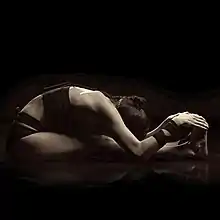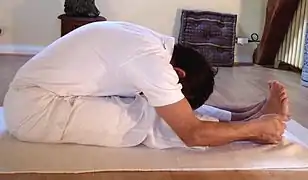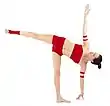Paschimottanasana
Paschimottanasana (Sanskrit: पश्चिमोत्तानासन; IAST: paścimottānāsana), Seated Forward Bend,[1] or Intense Dorsal Stretch[2] is a seated forward-bending asana in hatha yoga and modern yoga as exercise.

Etymology and origins

The name comes from the Sanskrit words paschima (पश्चिम, paścima) meaning "west" or "the back of the body";[3] uttana (उत्तान, uttāna) meaning "intense stretch" or "straight" or "extended";[4] and asana (आसन, āsana) meaning "posture" or "seat".[5]
The pose is described in the 15th-century Hatha Yoga Pradipika, chapter 1, verses 28-29.
Description
The pose is entered from Dandasana (the seated Staff Pose) by bending forward from the hips without straining and grasping the feet or lower legs. A strap may be placed around the feet and grasped in the hands if the back is stiff. The head may be rested on a folded blanket or bolster, which may be raised on a small stool if necessary.[6][7]
People who have difficulty bending their backs should exercise caution when performing this asana.[8]
Variations
Urdhva Mukha Paschimottanasana is a balancing form of the pose, legs and hands pointing upwards.[9][10]
Parivritta Paschimottanasana is the reversed or twisted form of the pose, the body twisted to one side and the hands reversed, so that if the body is turned to the left, the right hand grasps the left foot, the right elbow is over the left knee, and the left hand grasps the right foot.[11]
Trianga Mukhaikapada Paschimottanasana has one leg bent as in Virasana.[12]
Ardha Baddha Padma Paschimottanasana has one leg crossed over the other as in Padmasana.[13]
Gallery
See also
- Uttanasana, a standing forward bend
References
- "Yoga Journal - Seated Forward Bend". Retrieved 2011-04-10.
- "Asanas - Forward Bending Poses". About Yoga. Retrieved 2011-06-25.
- Lark, Liz (15 March 2008). 1,001 Pearls of Yoga Wisdom: Take Your Practice Beyond the Mat. Chronicle Books. p. 265. ISBN 978-0-8118-6358-2. Retrieved 25 June 2011.
- "Paschimottanasana". Ashtanga Yoga. Archived from the original on 2011-04-13. Retrieved 2011-04-10.
- Sinha, S. C. (1 June 1996). Dictionary of Philosophy. Anmol Publications. p. 18. ISBN 978-81-7041-293-9.
- Iyengar 1991, pp. 166-170.
- Mehta 1990, p. 64.
- Kapadia, Praveen (2002). Yoga Simplified (1st ed.). Hyderabad, India: Gandhi Gyan Mandir Yoga Kendra. pp. 124–125.
- "Urdhva-Mukha Paschimottanasana". Ashtanga Yoga. Retrieved 8 February 2019.
- Iyengar 1991, p. 173.
- Iyengar 1991, pp. 170-173.
- Iyengar 1991, pp. 156-157.
- Iyengar 1991, pp. 153-156.
Sources
- Iyengar, B. K. S. (1991) [1966]. Light On Yoga. Thorsons. pp. 166–170. ISBN 978-1855381667.
- Mehta, Silva; Mehta, Mira; Mehta, Shyam (1990). Yoga: The Iyengar Way. Dorling Kindersley. ISBN 978-0863184208.
- Saraswati, Swami Satyananda (1 August 2003). Asana Pranayama Mudra Bandha. Nesma Books India. ISBN 978-81-86336-14-4.
- Saraswati, Swami Satyananda (2004). A Systematic Course in the Ancient Tantric Techniques of Yoga and Kriya. Nesma Books India. ISBN 978-81-85787-08-4.


_from_Jogapradipika_1830_(detail).jpg.webp)

